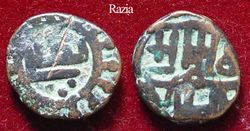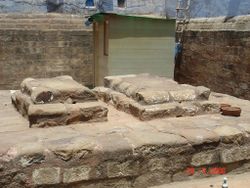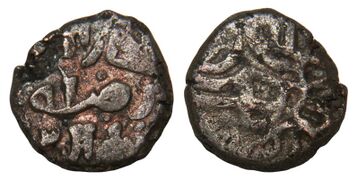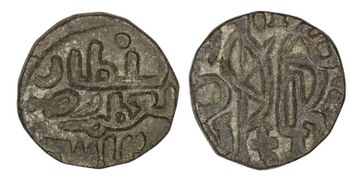رضية سلطانة
للفيلم الهندي، انظر رضية سلطانة (فيلم)
| رضية الدين والدنيا | |||||
|---|---|---|---|---|---|
| سلطانة، پادشاه | |||||
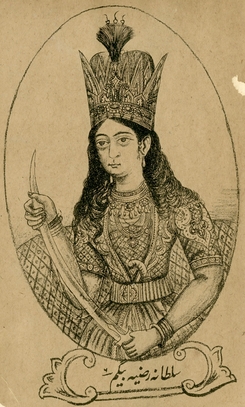 | |||||
| سلطان دلهي الخامس | |||||
| العهد | 1236 − 20 أبريل 1240 | ||||
| سبقه | ركن الدين فيروز | ||||
| تبعه | معز الدين بهرام | ||||
| توفي | 15 أكتوبر 1240 كيتهل، سلطنة دلهي | ||||
| الدفن | بلبل خانة، بالقرب من بوابة التركمان، دلهي | ||||
| الزوج | اختيار الدين ألتونيا | ||||
| |||||
| البيت | الأسرة المملوكية | ||||
| الأب | إلتـُتـْمـِش | ||||
| الأم | Turkan Khatun | ||||
| الديانة | الإسلام السني | ||||
رضية الدين والدنيا بنت إلتـُتـْمـِش (1205 - 15 أكتوبر 1240)، هي سلطانة من مماليك دلهي تولت العرش في الفترة (1236 - 1240) خلفا لأخيها ركن الدين فيروز ، وهي إبنه السلطان شمس الدين إلتـُتـْمـِش. وقد كانت تدربت في حياة والدها على تنظيم الدولة وتولي شئون الجيوش وكان يعدها لتكون ولية عهده..[1]
A daughter of Mamluk Sultan Shamsuddin Iltutmish, Razia administered Delhi during 1231–1232 when her father was busy in the Gwalior campaign. According to a possibly apocryphal legend, impressed by her performance during this period, Iltutmish nominated Razia as his heir apparent after returning to Delhi. Iltutmish was succeeded by Razia's half-brother Ruknuddin Firuz, whose mother Shah Turkan planned to execute her. During a rebellion against Ruknuddin, Razia instigated the general public against Shah Turkan, and ascended the throne after Ruknuddin was deposed in 1236.
Razia's ascension was challenged by a section of nobles, some of whom ultimately joined her, while the others were defeated. The Turkic nobles who supported her expected her to be a figurehead, but she increasingly asserted her power. This, combined with her appointments of non-Turkic officers to important posts, led to their resentment against her. She was deposed by a group of nobles in April 1240, after having ruled for less than four years. She married one of the rebels – Ikhtiyaruddin Altunia – and attempted to regain the throne, but was defeated by her half-brother and successor Muizuddin Bahram in October that year, and was killed shortly after.
الأسماء والألقاب
Razia's name is also transliterated as Raḍiyya[2] or Raziyya.[3] The term "Sultana", used by some modern writers, is a misnomer as it means "the king's wife" rather than "female ruler". Razia's own coins call her Sultan Jalalat al-Duniya wal-Din or as al-Sultan al-Muazzam Raziyat al-Din bint al-Sultan. The Sanskrit-language inscriptions of the Sultanate call her Jallaladina, while near-contemporary historian Minhaj calls her Sultan Raziyat al-Duniya wa'l Din bint al-Sultan[4] or Sultan Raziyat al-Duniya wa'l Din bint al-Sultan.[5] Another masculine title padshah(badshah) was also given to Razia.[6][7][8]
حياتها
توفي السلطان شمس الدين إلتـُتـْمـِش سنة (634هـ= 1236 م) وخلفه ابنه ركن الدين فيروز، غير أنه كان منشغلا عن مسئولية الحكم وتبعاته باللهو واللعب، تاركا تصريف أمور دولته إلى أمّه التي استبدّت بالأمر وهو ما جعل الأحوال تزاد سوءا، وتشتعل المعارضة ضده، وانتهت الأزمة بأن بايع كثير من الأمراء رضية الدين بنت التتمش، وأجلسوها على عرش السلطنة، وكانت تتمتع بصفات طيبة من رجاحة العقل، وشجاعة النفس، وعلى حظ كبير من الذكاء، حفظت القرآن الكريم ، وتلم بالفقه الإسلامي.
وكان أبوها يسند إليها بعض المهام ، حتى إنه فكّر في أن يجعلها "وليّة للعهد" دون إخوانها الذكور الذين انشغلوا باللهو والملذات، وقد تحقق ما كان يراه أبوها ولا يراه سواه ممن كانوا يعترضون عليه إيثاره لها، فما إن آلت إليها السلطنة حتى دلّت على ما تتمتع به من صفات، حتى إن مؤرخي الهند، أطلقوا عليها اسم "ملكة دوران بلقيس جهان"، أي فتنة العالم. [9]
العرش
جلست "رضية الدين" على عرش سلطنة دلهي نحو أربع سنوات (634-637هـ= 1236-1240م) بذلت ما في وسعها من طاقة لتنهض بالبلاد التي خوت خزائنها من المال لإسراف أخيها، وسارت على خطا أبيها في سياسته الحكيمة العادلة، لكنها اصطدمت بكبار أمراء الملوك الذين يشكلون جماعة الأربعين، ويستأثرون بالسلطة والنفوذ، وحاولت الملكة جاهدة أن تسوسهم، وتحتال على تفريق كلمتهم، وتعقُّب المتمردين والثائرين عليها، وكانت تظهر بمظهر الرجال، وتجلس على العرش والعباءة عليها، والقلنسوة على رأسها وتقود جيشها وهي تمتطي ظهر فيلها.
فترة ولاياتها
ولما استقرت أحوال مملكتها انصرفت إلى تنظيم شئونها، فعينت وزيرا جديدا للبلاد، وفوضت أمر الجيش إلى واحد من أكفأ قادتها هو "سيف الدين أيبك"، ونجحت جيوشها في مهاجمة قلعة "رنتهبور" وإنقاذ المسلمين المحاصرين بها، وكان الهنود يحاصرون القلعة بعد وفاة أبيها السلطان "التتمش".
الإطاحة بها
غير أن هذه السياسة لم تلق ترحيبا من مماليك سلطنتها الذين أنفوا أن تحكمهم امرأة، وزاد من بغضهم لهذا الأمر أن السلطانة قرّبت إليها رجلا فارسيًا يُدعى "جمال الدين ياقوت"، كان يشغل منصب قائد الفرسان، ولم تستطع السلطانة أن تُسكت حركات التمرد التي تقوم ضدها، كما كانت تفعل في كل مرة، فاجتمع عليها المماليك وأشعلوا الثورة ضدها، وحاولت أن تقمعها بكل شجاعة، لكنها هُزمت، وانتهى الأمر بقتلها في (25 ربيع الأول 637هـ= 25 أكتوبر 1239م) وتولَّي أخيها السلطان "معز الدين" عرش البلاد.
The nobles who supported Razia intended her to be a figurehead, but she increasingly asserted herself. For example, her initial coins were issued with her father's name, but by 1237–1238, she had started issuing coins solely in her own name.[10] Isami mentions that initially, she observed purdah: a screen separated her throne from the courtiers and the general public, and she was surrounded by female guards. However, later, she started appearing in public dressed in traditional male attire, wearing a cloak (qaba) and a hat (kulah). She rode on elephants through the streets of Delhi, making public appearances like the earlier Sultans.[11]
Razia's increasing assertiveness and her appointment of non-Turkic people to important posts created resentment among the Turkic nobles.[11] The post of Amir-i Akhur had previously been held by officers of Turkic origin, and Yaqut was of Abyssinian origin: therefore, Razia's Turkic officers resented this appointment.[11] Chroniclers such as Isami, Sirhindi, Badauni, Firishta, and Nizamuddin Ahmad attribute Razia's intimacy with Yaqut as a major cause of her downfall.[12]
In 1238–1239, Malik Izudin Kabir Khan Ayaz – the governor of Lahore – rebelled against Razia, and she marched against him, forcing him to flee to Sodhra. Because the area beyond Sodhra was controlled by the Mongols, and because Razia continued to pursue him, Izzuddin was forced to surrender and accept Razia's authority once again. Razia treated him leniently; she took away the iqta of Lahore from him, but assigned him the iqta of Multan, which Iltutmish had assigned to Ikhtiyaruddin Qaraqash Khan Aitigin.[13]
Razia had recalled Ikhtiyaruddin Aitigin, a Turkic slave purchased by Iltutmish, to her court in Delhi, and made him Amir-i Hajib. She had also bestowed favours upon another slave of Iltutmish – Ikhtiyaruddin Altunia, by assigning him first the iqta of Baran, and then, the iqta of Tabarhinda. However, these two officers conspired with other Turkic officers to overthrow her, while she was away on the Lahore campaign.[14] Razia arrived in Delhi on 3 April 1240, and learned that Altunia had rebelled against her in Tabarhinda. Unaware that other nobles in Delhi had joined Altunia in conspiring against her, Razia marched towards Tabarhinda ten days later. At Tabarhinda, the rebel forces killed her loyalist Yaqut, and imprisoned her.[15]
According to Minhaj, Razia ruled for 3 years, 6 months, and 6 days.[16]
التحالف مع ألتونيا ووفاتها
When the news of Razia's arrest reached Delhi, the rebel nobles there appointed Muizuddin Bahram – a son of Iltutmish – on the throne.[15] He formally ascended the throne on 21 April 1240, and the nobles pledged allegiance to him on 5 May 1240.[17] The nobles expected the new king to be a figurehead, and intended to control the affairs of the state through the newly created office of naib-i mamlakat (equivalent to regent), which was assigned to Ikhtiyaruddin Aitigin. However, the new king had Ikhtiyaruddin Aitigin assassinated within 1–2 months.[18]
After deposing Razia, the nobles at Delhi had distributed important offices and iqtas among themselves, ignoring claims of Ikhtiyaruddin Altunia, who had arrested Razia at Tabarhinda. After Aitigin's death, Altunia lost all hope of realizing any benefits from Razia's overthrow, and decided to ally with her. Razia also saw this as an opportunity to win back the throne, and married Altunia in September 1240. The two were supported by some other disgruntled Turkic nobles, including Malik Qaraqash and Malik Salari.[15]
Altunia assembled an army, which according to Abdul Malik Isami, included Khokhars, Jats, and Rajputs. In September–October 1240, Sultan Muizuddin Bahram led an army against the forces of Altunia and Razia, and defeated them on 14 October 1240. Altunia and Razia were forced to retreat to Kaithal, where they were deserted by their soldiers, and were killed by a group of Hindus. Razia was killed on 15 October 1240. [19][15][20]
She remains the only woman to have sat upon the throne of Delhi.[21]
ضريح رضية
The grave of Razia is located at Mohalla Bulbuli Khana near Turkman Gate in Old Delhi.[22] The 14th century traveler Ibn Batuta mentions that Razia's tomb had become a pilgrimage centre:[2] A dome had been built over it, and people sought blessings from it.[3]
Razia's grave is said to have been built by her successor and half-brother Bahram. Another grave, said to be of her sister Shazia, is located beside her grave. Razia was a devotee of the Sufi saint Shah Turkman Bayabani, and the place where she is buried is said to be his hospice (khanqah).[23][صفحة مطلوبة]
Today, the site is largely neglected: the Archaeological Survey of India performs annual maintenance to it, but has been unable to beautify it further because it is surrounded by illegal construction, and is approachable only through a narrow, congested lane. In the late 20th century, the local residents constructed a mosque near it.[22]
A ruined building in Kaithal is purported to be the site of Razia's original grave.[24][25]
العملات
Coins of Razia are found in silver and billon; one gold coin of Bengal style is also known. Silver Tankas were issued from both Bengal (Lakhnauti) and Delhi. Initially she issued coins from Delhi in the name of her father Iltumish citing the title Nasrat i.e. female title of Nasir.[26]
- Razia's jaital's Billon coins
الصور
Several Indian films have portrayed the empress. Razia Begum (1924) was an Indian silent film by Nanubhai B. Desai and Bhagwati Prasad Mishra. Devendra Goel directed Razia Sultana, a 1961 Indian Hindi-language film which starred Nirupa Roy in the titular role. A notable portrayal was by Hema Malini in the 1983 biopic Razia Sultan by Kamal Amrohi.[27]
In 2015, And TV started airing Razia Sultan, a TV series on the life of Razia, starring Pankhuri Awasthy as Razia and Rohit Purohit as Altunia.[28]
Rachel Gill portrayed a character of the same name, inspired by the empress in 2016 Pakistani film Saya e Khuda e Zuljalal.[29]
انظر أيضا
الأدب
- Jamila Brijbhushan, Sultan Raziya, Her Life and Times: A Reappraisal, South Asia Books (1990) ISBN 8185425094
- Rafiq Zakaria, Razia, Queen of India, Oxford University Press (1966)
المصادر
- ^ Gloria Steinem (Introduction), Herstory: Women Who Changed the World, eds. Deborah G. Ohrn and Ruth Ashby, Viking, (1995) p. 34-36. ISBN 978-0670854349
- ^ أ ب Peter Jackson 2003, p. 46.
- ^ أ ب Guida M. Jackson 1999, p. 341.
- ^ K. A. Nizami 1992, p. 237.
- ^ Minhaj-i-Siraj, Abu-'Umar-i-'Usman (1873). The Tabakat-i-Nasiri. Translated by Major H. G. Raverty. London: Asiatic Society of Bengal. p. 637.
- ^ Saturday Review: Politics, Literature, Science and Art (in الإنجليزية). Vol. 41. Saturday Review. 1876. p. 397.
In the thirteenth century a woman, the celebrated Queen Raziya, ascended the throne of Delhi and reigned for the brief space of four years. She bore the title of Sultan and was sometimes called Badshah.
- ^ A. V. Williams Jackson, ed. (1907). History of India (in الإنجليزية). Vol. 5. Grolier Society. p. 104.
It will be noted that Minhaj always speaks of the queen as "Sultan," since this title, or that of Padshah, "king," was given to her,
- ^ Henry Miers Elliot. John Dowson (ed.). The History of India, as Told by Its Own Historians. Vol. 2. p. 332.
The queen is always called "Sultán" and "Bádsháh," not Sultána, as by Briggs and Elphinstone.
- ^ [http://www.islamonline.net/arabic/history/1422/06/article17.shtm إسلام أون لاين]
- ^ Peter Jackson 2003, p. 47.
- ^ أ ب ت K. A. Nizami 1992, p. 240.
- ^ Sudha Sharma 2016, p. 141.
- ^ K. A. Nizami 1992, pp. 240–241.
- ^ K. A. Nizami 1992, p. 241.
- ^ أ ب ت ث K. A. Nizami 1992, p. 242.
- ^ K. A. Nizami 1992, p. 243.
- ^ K. A. Nizami 1992, p. 244.
- ^ K. A. Nizami 1992, pp. 242–244.
- ^ Lyons 2022.
- ^ Gabbay, Alyssa (1 January 2011). "In Reality a Man: Sultan Iltutmish, His Daughter, Raziya, and Gender Ambiguity in Thirteenth Century Northern India" (PDF). Journal of Persianate Studies. Brill Publishers. 4 (1): 48. doi:10.1163/187471611X568285. eISSN 1874-7167. ISSN 1874-7094. LCCN 2008236337. Retrieved 11 July 2021 – via UNCG University Libraries.
The troops accompanying the couple abandoned them, and both Raziya and her husband were killed near Kaithal on 25 Rabiʿ I 638/14 October 1240.
- ^ Srivastava, Ashirbadi Lal (1964). The Sultanate of Delhi (711-1526 A.D.) 4th edition. Agra: Shiva Lal Agarwala & Co. (P.) Ltd. pp. 105–106.
- ^ أ ب Syed Abdullah Zaini (9 August 2013). "A forgotten tomb".
- ^ Rana Safvi, The Forgotten Cities of Delhi. Quote: "The lanes leading to her tomb are very confusing and one has to ask for directions at Bhojala Pahari. There is an ASI board which leads into Bulbuli Khana. At the end of some narrow, dingy lanes is another stone sign by ASI, which announces the last resting place of South Asia's first female monarch."
- ^ "Tomb of Razia Sultan". Haryana Tourism. Retrieved 10 January 2020.
- ^ Sukhbir Siwach (Jun 13, 2014). "Kaithal farmer stands in way of Razia Sultan memorial | Chandigarh News - Times of India". The Times of India (in الإنجليزية). Retrieved 2022-04-26.
- ^ Stan Goron; J. P. Goenka (2001). The Coins of the Indian Sultanates. Munshiram Manoharlal. p. 26. ISBN 9788121510103.
- ^ Rajadhyaksha, Ashish; Willemen, Paul (1999). Encyclopaedia of Indian cinema. British Film Institute. Retrieved 12 August 2012.
- ^ PTI (4 February 2015). "TV show about women emperor Razia Sultan launched". Indian Express. Retrieved 18 January 2020.
- ^ "Rachel Gill as Razia Sultana? The model has big shoes to fill in her debut film". Images by Dawn. 5 October 2016. Retrieved 15 April 2023.
| سبقه ركن الدين فيروز |
المماليك | تبعه معز الدين بهرام |
| سبقه معز الدين بهرام |
المماليك | تبعه معز الدين بهرام |
